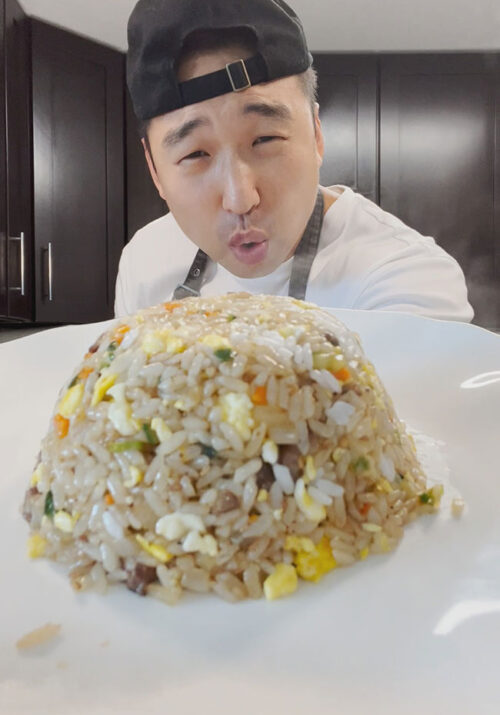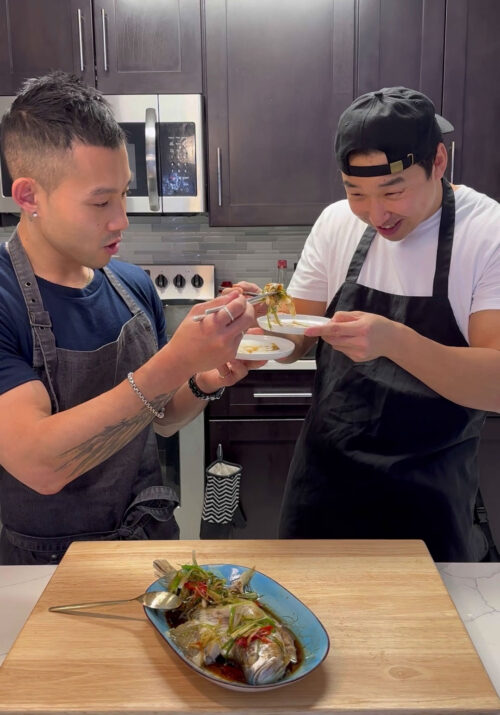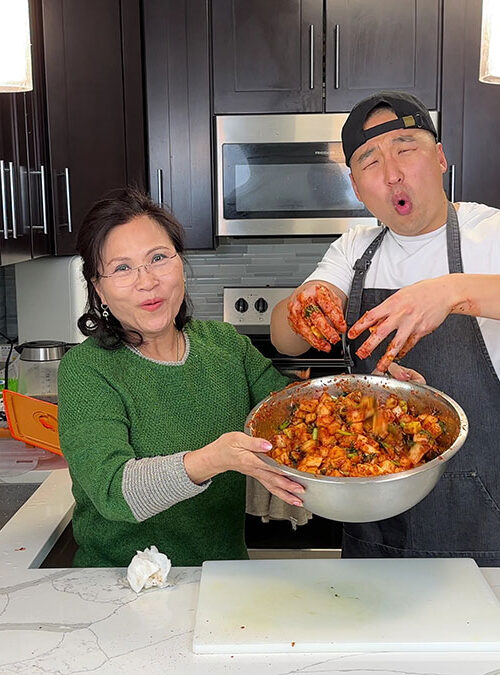
Jjampong is a spicy noodle soup that is filled with seafood and vegetables. Its fiery red soup intimidates but the contents will fill you up and refreshes you. Comfort in every sip!
Jjampong is a dish that was brought by Chinese immigrants to Korea. The original recipe might have been different so you don’t see a similar dish in China, but this spicy noodle soup is already the adapted version to the Korean palette.
Along with dishes like Jjajangmyeon, Tangsuyuk, and Kkanpungi—these four were all from Chinese origins so there are establishments that exclusively serve these.
Don’t mistake this as a limitation though! These four can be paired interchangeably and sometimes we even get confused about which one we want. Half the time, we end up ordering all of it and leave the place super satisfied.
This Korean Spicy Seafood Noodle Soup does not fail to hit your spicy cravings. The soup is indulgent and savory yet light and refreshing because of the seafood and vegetables that get entangled with each other. Personally, I am a jjajangmyeon kid, but as I grew up, I began to appreciate this soup more and more!
Ingredients for Korean Spicy Seafood Noodle Soup
Disclaimer: I get a small commission at no additional cost to you when you make a qualified purchase under the affiliate links.
Noodles

The noodles we’re going to use here are fresh. When you go to an Asian store, it can be called “Chinese fresh egg noodles”, “hand-pulled noodles”, or “jjajang noodles”. Since they are fresh, they are usually placed in the chiller.
The strands are usually not too thin, not too thick, and have a chewy texture which makes this more enjoyable to eat. If you cannot find one, spaghetti noodles can also be a substitute.
Seafood

There is a wide variety of seafood you can add to jjamppong. Shrimp, crab, clams, mussels, scallops, squid, and even oysters—whichever you prefer, you can freely use them.
Fresh seafood or frozen seafood works fine. Just make sure to thaw out and drain your seafood well so it doesn’t make the noodle soup watery. In general, I used 220 grams of seafood in total, but the more seafood you use, the better it tastes!
Vegetables

Like the seafood, there are also a wide variety of vegetables you can use in this dish. From jalapeno peppers, Vietnamese peppers, scallions, onion, shiitake mushrooms, wood-ear mushrooms, carrots, zucchini, bokchoy, or cabbage.
You only need small portions of a combination of these vegetables or 150 grams in total, especially since this is only one serving. Feel free to multiply for more portions! Slice them in the same matchstick or julienne sizes so it is easier to scoop with your chopsticks.
Seasonings
The seasonings are few and simple!
- Garlic
- Red Pepper Powder or Gochugaru (Fine Grind) – This is going to be the base of the soup which will bring spice and a bright red color. If you can’t find the fine grind, coarse grind gochugaru is ok. I just prefer the fine grind so it dilutes well into the soup and it also has a hint of smoky flavor.
- Soup Soy Sauce – This is a little saltier than the regular soy sauce so a small amount can season the soup well without changing its color.
- Salt and Pepper – To further bring out the natural flavors of the seafood and vegetables, salt and pepper are all you need.
- Chicken or Seafood Stock – While flavors are coming from the seafood, veggies, and umami from the soy sauce, the stock will make the soup richer and tastier. Nevertheless, water is also fine!
How to Make Jjampong
Prepare your ingredients by making sure the seafood you will use are drained well and by chopping your vegetables of choice into julienne or matchstick sizes.

In high heat, with a tablespoon of oil, saute the garlic, scallions, and chili peppers. Allow it to become fragrant and a little bit toasted. This is called “pagirum” or scallion oil, and all good dishes start with scallion oil!

Once the aromatics are fragrant, add the seafood and quickly saute them. Coat each well with the garlic and scallions. In a couple of minutes, the colors of the seafood will brighten and it should turn the dish even more fragrant.

Add the vegetables altogether and saute them for about two minutes.

Now season the stir-fried seafood and vegetables with gochugaru, soy sauce, and black pepper. Continue to stir fry and make sure to coat everything with the seasonings, allowing the spice and natural flavors from the ingredients to come out and infuse together.

Once it is fragrant, add water and season with salt and hondashi or ramen powder. Mix well until it turns into a bright red soup. Allow it to boil for a couple of minutes.

In a separate pot, bring water to a boil, and place your noodles to cook. Occasionally stir the noodles so it doesn’t stick and air it out so it becomes chewy. Once cooked, drain and rinse to remove excess starch from the noodles.
Taste and adjust the soup. If it’s bland, add more salt. If it’s salty, add more water. But in general, it needs to be a little bit salty because you will still add noodles to it.


To plate, place noodles in a bowl, top with the seafood and vegetables, then pour soup onto the bowl. Super simple and super easy recipe! Serve hot and enjoy!
More Tips to Make the Best Jjampong

- Saute in high heat! This will help to quickly cook the seafood and vegetables so that they don’t turn into a chewy, watery, and mushy mess. Additionally, it will add a bit of smokiness to the soup!
- If you don’t have chicken or Korean soup stock, use hondashi or ramen soup powder. This is a simple trick I like to do when I do not have a ready-to-use stock at home. A small amount will go a long way!
- Make it as spicy as you like! In my recipe, I added some jalapeno and Vietnamese chili peppers for an intense kick. Feel free to add or subtract according to your spice tolerance. The Viet peppers may be small, but they are extremely spicy so handle it carefully!
- Cook the noodles separately. This will prevent the excess starch from making the soup thick—we want to keep it as light as possible. If you want the noodles to remain hot, pass some hot water over it after rinsing.
- If you have any leftover soup, they will refrigerate well. Reheat the soup on the stove or the microwave as needed, then pour over cooked noodles or rice! Yes, it also goes well with rice!
Other noodle Korean noodle recipes you might like:
- Bibim Guksu (Spicy Cold Noodle Soup)
- Kong Guksu (Cold Soybean Noodle Soup)
- Oi Naengguk (Cold Cucumber Soup)
- Sujebi (Hand-torn Noodle Soup)
- Hangover Ramen
Make sure to leave a rating, a comment, or tag me on Facebook, Instagram, or Tiktok when you chop them up! Yeobosayo!
Jjampong Recipe (Korean Spicy Seafood Noodle Soup)
Ingredients
- 1 serving Jjajang Noodles
Seafood
- 50 grams Peeled Shrimp
- 1 pc Big Shrimp
- 6 pcs Short Neck Clam
- 100 grams Squid Sliced into strips
Vegetables
- 1 tbsp Garlic Minced
- 1 stalk Scallions Chopped
- 30 grams Onion Julienne
- 1 pc Jalapeno Chopped
- 1 pc Vietnamese Red Pepper Chopped
- 20 grams Woodear Mushrooms Chopped to bitesize pieces
- 2 pcs Shiitake Mushrooms Sliced
- 50 grams Cabbage Chopped into strips
Spicy Soup Base
- Vegetable or Canola Oil For sauteing
- 3 cups Water
- 3 tbsp Gochugaru Fine grind
- 1 tbsp Soy Sauce for Soup
- Black Pepper To taste
- 1 tsp Salt
- Hondashi or Shin Black Seasoning Packet
Instructions
- In a pan, saute garlic, scallions, and chili peppers.
- Once fragrant, add the seafood, and saute it in the scallion oil until it’s even more fragrant.
- Throw in the vegetables, and cook them on high heat for about 2 minutes.
- Season the seafood and vegetables with gochugaru, soy sauce for soup, and black pepper. Mix it well until everything is coated with the seasonings.
- Add water, season with salt and hondashi or ramen soup powder, then let it come to a boil.
- Meanwhile, in a separate pot, bring water to a boil. Cook the noodles in it, stirring occasionally and airing it out.
- Once the noodles are cooked, drain and rinse to remove excess starch.
- Taste and adjust the soup. If it’s bland, add more salt. If it’s salty, add more water. But generally, you want it to be a little salty because you will still add noodles.
- Plate the noodles, top with the seafood and vegetables, and pour the soup. Serve hot and enjoy!






Leave a Reply